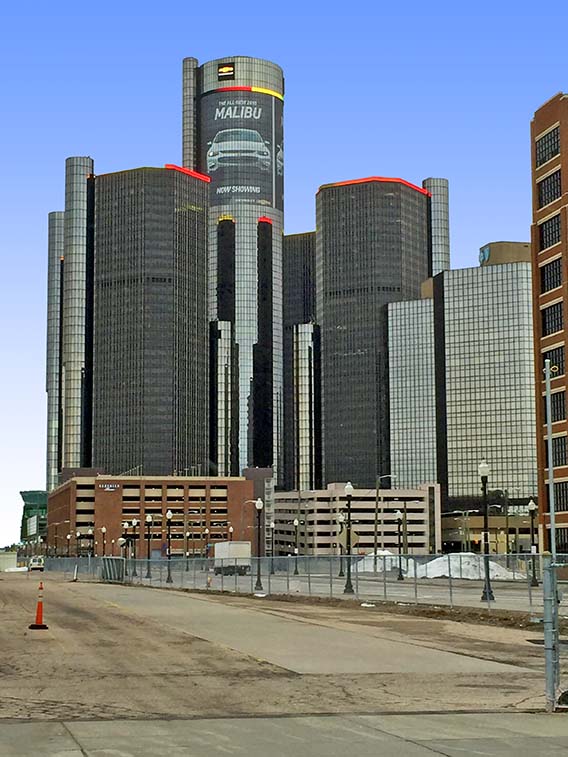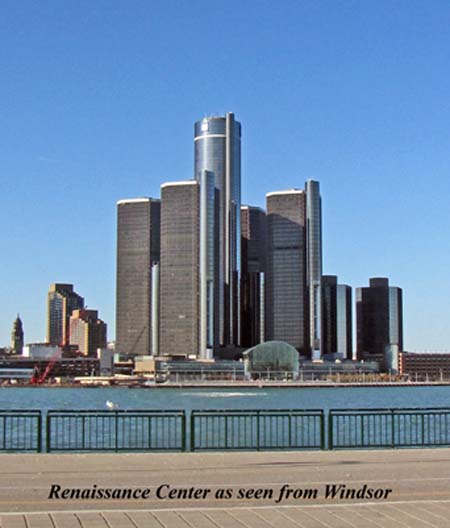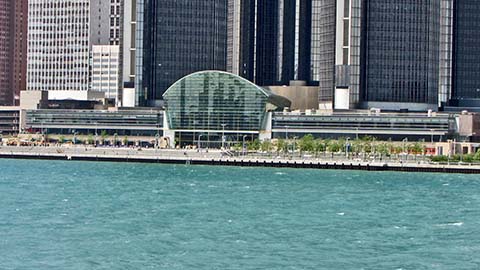

The Renaissance Center complex with it seven
glass building is now Detroit's signature. Just after the riot of 1967,
Detroit's financial
leaders sought to develop innovative strategies to solve the city's challenges.
Key individuals included Henry Ford II, J. L. Hudson of the department store
chain and Max Fisher who became wealthy with Marathon Oil. After the riot,
they successfully encouraged Detroit employers to hire many inner city individuals
in hopes that jobs would prevent more violence. Unfortunately, macro economic
changes in 1969 led to uncertain times, accelerating interest rates, sharp
declines
in auto production, and then the rapid layoff of new employees. 
These leaders wished to create a development in downtown Detroit that would symbolize to the world the effective way Detroit rebounded from the riot, and would simultaneously serve as a magnet reversing the tremendous flow of businesses and trade from the city to the suburbs. By 1971, Henry Ford II, had assembled a coalition—the Renaissance Center Partnership—of 51 businesses to build a magnificent edifice on the riverfront. The 1970s were very unsettled economic years for Detroit and the nation, so Henry Ford II deserves great credit for undertaking what was then the nation's largest privately financed real estate development—a cost of $350 million.
John Portman and Associates were selected to design the glass-fronted complex that includes a 73-story cylindrical hotel, four 39-story office buildings and two much smaller 21-story office buildings. Although striking—and quite beautiful from some perspectives—the Ren Center has won only modest praise from architectural and urban critics. It may not effectively capitalize upon its riverfront location; actually, it seems to block the river from Detroit's downtown. It may lack the warmth and ingenuity of Rowland's Guardian Building or the ascetic appeal of Kahn's Fisher Tower. Also it is easier to appreciate the attractiveness of the Ren Center from Windsor than from Detroit.
Monday,
July 25, 1967 was perhaps the most frightening day in Detroit since the British
occupied the city in the War
of 1812. The city
was bl anketed with dense smoke from burning homes and shops, the fire department
responded
to calls selectively, if at all, and, from the higher levels of downtown
buildings, observers saw flames billowing from many locations. Fears of the
city burning down were realistic. This generated new challenges for urban
architects—designing building that could not easily be attacked and
burned by urban rioters. For the Ren Center, the architects built a substantial
perimeter
barrier along
Jefferson, one that effectively and clearly isolated the Ren Center from the
city of Detroit. The architects assumed that vines would hide the barrier,
but
it included heating equipment that prevented the growth of anything live.
anketed with dense smoke from burning homes and shops, the fire department
responded
to calls selectively, if at all, and, from the higher levels of downtown
buildings, observers saw flames billowing from many locations. Fears of the
city burning down were realistic. This generated new challenges for urban
architects—designing building that could not easily be attacked and
burned by urban rioters. For the Ren Center, the architects built a substantial
perimeter
barrier along
Jefferson, one that effectively and clearly isolated the Ren Center from the
city of Detroit. The architects assumed that vines would hide the barrier,
but
it included heating equipment that prevented the growth of anything live.
The interior was designed with an 8-story atrium, 5 levels of intersecting walkways and a one-half acre pool. There were hopes that the nation's retailers would open shops there, but this never happened. Indeed, the interior design was severely criticized since most people found it very hard to orient themselves or move from one level to another without getting lost.
The Ren Center was completed in 1981, and was pretty much a financial failure for its first 17 years. Ford Motor Company moved some of their offices to the building, but there was no overwhelming demand for office space at the Ren Center, and the hotel limped along. In the late 1990s, GM sought an alternative for their aging headquarters on West Grand—the massive building designed by Albert Kahn and opened in 1922. They bought the Ren Center for about one-tenth of the construction cost. GM invested approximately $500 million in the office buildings and hotel. They added an attractive and large winter garden opening on the waterfront. Although the fear of terrorism in urban areas rose after September 2001, fears of urban racial riots decreased and, in 2002, the barriers separating the Ren Center from Detroit were removed. By 2003, it appears that the Ren Center is serving the purpose Henry Ford II foresaw. GM has purchased several neighboring building and surrounding property, so the presence of their headquarters appears to be stimulating commercial and residential development along the riverfront.
Architect: John Portman and Associates
Date of Completion: 1981
Architect for renovations begun in 2000: Skidmore, Owings and Merrill
Use in 2003: The 73 story cylinder is a Marriott Hotel. GM uses the four 39-story
office buildings. The two 21-story office buildings are, I believe, not
very utilized but GM has been negotiating tax abatements with the city of Detroit
in the expectation that suppliers will locate their offices in these buildings.
Return to Commerical Buildings